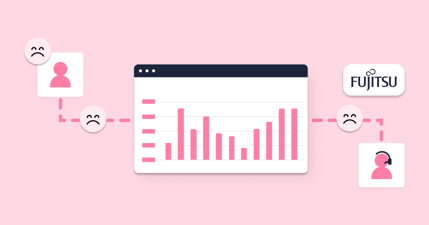6 More Reasons Why the Belief That Employee Experience Doesn’t Matter to MSPs is Flawed
In the second part of this series, I challenge six more flawed assumptions or misinformed beliefs that people might have related to employee experience and experience management in the context of the managed service provider (MSP) operating model.

In my previous blog, I challenged eight flawed assumptions or misinformed beliefs that people might have related to employee experience and experience management in the context of the managed service provider (MSP) operating model. The more I wrote, the more I realized that a wide range of flawed beliefs collectively contribute to the overarching idea that employee experience doesn’t matter to MSPs. This second blog continues my examination of these flawed beliefs. Please keep reading to find out more.
Flawed belief #9: MSPs and their clients can’t work together to win together
How often, in a business context, have you seen different parties working against each other rather than together (despite having a common goal)? It’s the proverbial “us and them” scenario – where the lack of trust, defensiveness, and other issues contribute to both parties not achieving the level of success that collaborative working would have delivered.
This behavior can be seen in clients’ relationships with their MSPs, where the lack of trust eats into both parties’ opportunities for success. For example, restrictive and penalty-laced contractual requirements and targets cause a confrontational, rather than collaborative, relationship and a focus on meeting IT-related contractual targets rather than business success.
Experience management helps to address this issue and requires and encourages a change in mindset for both parties. Such that MSPs work together with their customers, using better data to have a shared understanding of how well they’re delivering IT services. This use of experience data not only identifies issues, but the MSP can also apply corrective measures more quickly. It’s a “win-win” for both parties, in terms of operations and outcome, and the foundation upon which greater trust and collaboration are built.
The MSP benefits are amplified, too, because the experience-related learnings and improvements from one client can be applied to other clients. A change can positively impact all clients, improving the employee experience for all end-users.
Flawed belief #10: Traditional MSP SLA targets are what matter most to clients
It makes sense that this belief is true. After all, the clients agreed and perhaps insisted on the service-level targets with their MSP. They also might use the service level agreement (SLA) to penalize their MSP financially when targets aren’t met.
But is this simply clients making the most of what’s available (to them) rather than focusing on something that gives them better insight into how their MSP is delivering against the corporate need for effective IT service delivery and support? For example, they don’t have the experience-related data and insights that offer an end-user view of performance rather than the service provider view.
For our customers and both MSPs and enterprises, access to experience data has proved the need for more than the traditional SLA targets. Not only in identifying issues but also in improving what matters most to end-users.
So this belief might hold true for some MSP clients, but be warned, organizations will increasingly understand the importance of experience data and its transformational effect on operations and outcomes. At some point in the not-too-distant future, the validity of this belief will change. As organizations understand what the “something” is, that gives them better insight into how their MSP (or internal IT department, for that matter) is delivering against their need for effective IT service delivery and support.
Flawed belief #11: Green SLA targets mean that the client is happy
MSPs are not alone in thinking that the “sea of green” shown on their performance management dashboards signifies that all is good with their IT service delivery and support capabilities. It’s a common flawed belief for enterprise organizations too, and the foundation for what has become known as “the watermelon effect” – where IT performance measures are green on the outside but once cut into, i.e., examined further, they’re red on the inside.
Most MSPs are focused on keeping that “sea of green.” If an SLA target turns red, people will focus on remedying the situation. But what if an SLA is consistently green? Likely, people won’t pay attention because the service is performing well. However, just because a target is green doesn’t mean that the end-users are happy. There might be a disparity between the measurement taken at the point of service creation and the view at service consumption.
So, how can your MSP get better insight into the end-user view of its IT service delivery and support performance? It’s what experience measurement and management were invented for – to allow service providers to understand what’s working well and what’s not (from an end-user perspective) and to address the highlighted issues.
For example, what if a new or revised process has been adopted to help your MSP serve its clients better but, from the end-user perspective, the service and experience are worse? Traditional IT performance metrics might show an increase in operational efficiency and throughputs but miss that the end-user experience has worsened. The critical question is, “Can clients be happy if their employees are unhappy?” It depends, but is your MSP willing to risk the loss of business that might result?
Ultimately, green SLA targets don’t automatically mean the client is happy. Instead, there’s also the need to look at IT service delivery and support performance at the point of consumption – and this is where experience management helps.
Flawed belief #12: Green SLA targets mean that there are no improvement opportunities
This flawed belief is a continuation of #11, where the perpetual “sea of green” might mean the impetus for operational or service improvement is lost. However, just as importantly, it might mean that while a consistent level of improvement investments is made, the gains are made in the wrong places. It’s perhaps improving operational capabilities that offer little additional value to clients or worsen the end-user experience.
Whatever the situation, it’s likely that your MSP’s consistently green SLA targets don’t mean that there are no improvement opportunities. Plus, it doesn’t know where the issues that matter most are.
Flawed belief #13: Digital transformation solves everything
Greater technology exploitation is improving organizations around the globe, especially on the back of digital transformation strategies that accelerated during the global pandemic. But it’s not as simple as “the more technology we add, the better our operations and outcomes get.” As with flawed belief #12, how does your MSP know it’s applying its likely limited digital transformation investments in the right places, i.e., on what matters most? Plus, does it know when digital transformation change unexpectedly creates worse end-user experiences and the unwanted client-retention consequences this might bring?
The bottom line is that while digital transformation improves workplaces, operations, and outcomes, we can’t assume that it always makes everything better for everyone. Our customer data proves this.
Flawed belief #14: Increased automation destroys the employee experience
In some ways, this is the reverse of flawed belief #13. The assumption is that people prefer the “human touch,” meaning that increased automation offers a worse employee experience. However, the consultant’s answer applies – “It depends.”
If new automation is introduced, including artificial intelligence (AI)-enabled capabilities, in the right way, it’s more likely to improve the employee experience. Whereas if little care is taken with success factors such as the motivation for change and the level of organizational change management (OCM) investment, it’s more likely for the employee experience to be at risk. Plus, of course, personal preferences and expectations come into play too.
Ultimately, increased automation can both destroy and enhance the employee experience. It’ll depend on those mentioned above and other factors, necessitating not only the right approach to automation adoption but also relevant success metrics to ensure that the introduced automation helps as expected and doesn’t hinder either service providers or service receivers.
Flawed belief #15 (and #8 in my first blog): Employee experience doesn’t matter to MSPs
As with my first blog, the seven flawed beliefs covered above add weight to the importance of experience management to MSPs. Experiences matter to MSPs, with end-user experience likely to grow in importance to the clients that employ MSPs and thus to MSPs as a consequence.
As with the flawed beliefs explained above, traditional MSP metrics need to change, and adding technology doesn’t automatically improve or reduce the delivered experiences. Instead, MSPs must embrace experience measurement and management to retain existing clients and win new ones.
Want to learn how to use experience data to optimize and manage collaboration with your MSP? Check out our Demo.
Related content

18.10.2022
8 Reasons Why the Belief That Employee Experience Doesn’t Matter to MSPs is Flawed
For a managed service provider (MSP) doing its best to serve its clients, the topic of employee experience might not ...
Read more >
01.02.2023
MSPs and the Need for Experience Management
Your managed service provider (MSP) might be assessing experience level agreements (XLAs) and employee experience ...
Read more >
